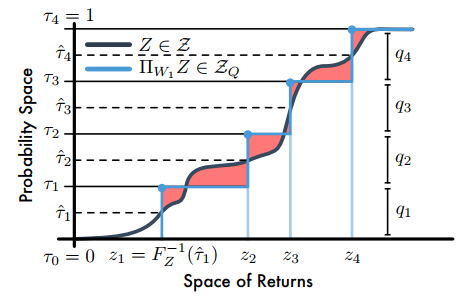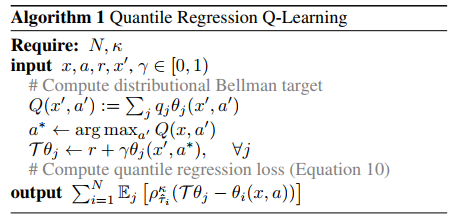C51算法理论上用Wasserstein度量衡量两个累积分布函数间的距离证明了价值分布的可行性,但在实际算法中用KL散度对离散支持的概率进行拟合,不能作用于累积分布函数,不能保证Bellman更新收敛;且C51算法使用价值分布的若干个固定离散支持,通过调整它们的概率来构建价值分布。
而分位数回归(quantile regression)的distributional RL对此进行了改进。首先,使用了C51的“转置”,即固定若干个离散支持的均匀概率,调整离散支持的位置;引入分位数回归的思想,近似地实现了Wasserstein距离作为损失函数。
Quantile Distribution
假设(mathcal{Z}_Q)是分位数分布空间,可以将它的累积概率函数均匀分为(N)等分,即( au_0, au_1..., au_N( au_i=frac{i}{N},i=0,1,..,N))。使用模型( heta:mathcal{S} imes mathcal{A} o mathbb{R}^N)来预测分位数分布(Z_ heta in mathcal{Z}_Q),即模型({ heta_i (s,a)})将状态-动作对((s,a))映射到均匀概率分布上。(Z_ heta (s,a))的定义如下
其中,(delta_z)表示在(zinmathbb{R})处的Dirac函数
与C51算法相比,这种做法的好处:
- 不再受预设定的支持限制,当回报的变化范围很大时,预测更精确
- 取消了C51的投影步骤,避免了一些先验知识
- 使用分位数回归,可以近似最小化Wassertein损失,梯度下降不再有偏
Quantile Approximation
Quantile Projection
使用1-Wassertein距离对随机价值分布(Zin mathcal{Z})到(mathcal{Z}_Q)的投影进行量化:
假设(Z_ heta)的支持集为({ heta_1,..., heta_N }),那么
其中,( au_i, au_{i-1}in[0,1])。论文指出,当(F_Z^{-1})是逆累积分布函数时,(F_Z^{-1}(( au_{i-1}+ au_i)/2))最小。因此,量化中点为(mathcal{hat au_i}=frac{ au_{i-1}+ au_i}{2}(1le ile N)),且最小化(W_1)的支持( heta_i=F_Z^{-1}(mathcal{hat au_i}))。如下图

【注】C51是将回报空间(横轴)均分为若干个支持,然后求Bellman算子更新后回报落在每个支持上的概率,而分位数投影是将累积概率(纵轴)分为若干个支持(图中是4个支持),然后求出对应每个支持的回报值;图中阴影部分的面积和就是1-Wasserstein误差。
Quantile Regression
建立分位数投影后,需要去近似分布的分位数函数,需要引入分位数回归损失。对于分布(Z)和一个给定的分位数( au),分位数函数(F_Z^{-1}( au))的值可以通过最小化分位数回归损失得到
最终,整体的损失函数为
但是,分位数回归损失在0处不平滑。论文进一步提出了quantile Huber loss:
Implement
QR TD-Learning
QRTD算法(quantile regression temporal difference learning algorithm)的更新
(asimpi (cdot|s),rsim R(s,a),s^primesim P(cdot|s,a),z^primesim Z_ heta(s^prime))
其中,(Z_ heta)是由公式(1)给出的分位数分布,( heta_i (s))是状态(s)下(F_{Z^pi (s)}^{-1}(mathcal{hat au}_i))的估计值。
QR-DQN
QR-DQN算法伪代码

Append
1. Dirac Delta Function
References
Will Dabney, Mark Rowland, Marc G. Bellemare, Rémi Munos. Distributional Reinforcement Learning with Quantile Regression. 2017.
Distributional RL